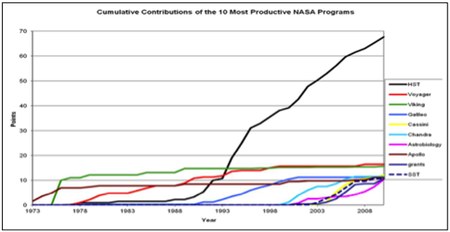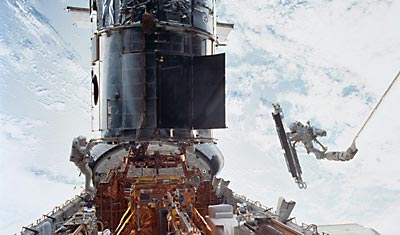A values-based approach toward national space policyby Matt Greenhouse
|
| Discovery is why a nation should go to space. It has been NASA’s only use of human spaceflight in the post-Apollo era that has returned value that is highly regarded by nearly everyone. |
Cold War-era chest-thumping demonstrations of the nation’s technical prowess, although appropriate to the Apollo era, have no place in present-day policy toward a sustainable program of human space exploration. A sustainable human space program must be geared toward goals and investments that yield a net tangible value to society. The investment portfolio must be balanced such that the time to realized-return is appropriate to one’s ability to forecast the future budget environment.
Discovery is why a nation should go to space. It is what inspires all of humanity. It has been NASA’s only use of human spaceflight in the post-Apollo era that has returned value that is highly regarded by nearly all people in developed countries with free access to information. The synergy that once existed between human-assisted and robotic space exploration in the Hubble Space Telescope (HST) program is a blueprint for sustained deep space human-assisted exploration that can stoke the nation’s competitiveness in science, technology, and math toward realization of long-term financial and physical security.
Development of the nascent technologies and spacecraft architectures for deep space telerobotic servicing is an enabling requirement for any sustainable exploration program. Future robotic space exploration necessitates very expensive assets in deep space. The $8-billion James Webb Space Telescope (JWST) is a current example. Under plausible economic conditions, assets of this value cannot be realistically produced on a cadence higher than one per decade. For space vehicles of this value, which are needed to advance understanding in astrophysics, enable exploration of other worlds in our solar system and those that orbit nearly every star in our galaxy, development of durable assets for in-flight refurbishment and repair is critical to achieving an executable and cost-effective program over the long term. A similar argument can be made for future defense space assets. Development of the nation’s capability for satellite servicing will require astronaut in-flight-assist activities over several decades.
The unparalleled success of the HST program, which has touched nearly every citizen, was entirely enabled by human satellite servicing. In this program, the servicing was hands-on and involved a coordinated design effort to develop a serviceable space vehicle and servicing systems to go with it. In the future, the same coordinated effort will be required. However, the astronaut’s hands will be on the controls of a telerobotic tool that is operating in deep space on an advanced spacecraft architecture that is designed to be serviced by it. Development of human-assisted exploration assets, and more advanced telerobotic tools for in-flight assembly of very large space vehicles, will require decades of human assistance in Earth orbit. Development of these enabling technologies for robotic scientific exploration and defense space applications should be the primary goal of NASA’s astronaut program and must precede any effort toward direct human exploration beyond cislunar space.
This vision is practical and achievable. It builds on NASA’s legacy of success in implementing science-driven missions that yield unambiguous return on investment. It is a vision that can withstand any National Academy of Sciences review process and maintain bipartisan support across multiple administrations and congresses. To implement this vision, key aspects of NASA’s internal prioritization and organization for its space portfolio would have to change.
| Formulation of the nation’s space policy and the resulting NASA organization do not reflect understanding of what NASA did right in development of the HST mission architecture. |
NASA’s current stated top three development programs are (in no particular order): the development of the Orion Multi-Purpose Crew Vehicle and Space Launch System (SLS); utilization of the International Space Station, including commercial crew development; and JWST. In the above vision of the future, there would be only two primary priorities: scientific exploration of space and development of the in-flight servicing capability needed to enable and sustain the scientific exploration effort. In this picture, Orion and SLS would be developed in context of a cohesive mission architecture for human-assisted exploration. Telerobotic satellite servicing in deep space would be the focus of human flight activities, possibly in partnership with defense-related agencies. The nation’s space policy would be designed around a core value that every flight mission, including those for which technology development is a key objective, must yield direct discovery return on investment. The Science Mission Directorate (SMD) would be responsible and accountable for all mission formulation activities across the agency’s space portfolio. SMD would utilize the processes of National Academy of Science decadal survey prioritization of science community-proposed missions and announcement of opportunity solicitations for free and open competitive selection of science missions to provide payloads to every technology development flight.
 Figure 1: The Science News metric shown above is an independent measure of the most important discoveries in science that were enabled by NASA flight missions. |
The power of this approach is illustrated in the figure above. When missions are formulated in an environment where SMD is the supported organization and the Human Exploration and Operations Mission Directorate is the supporting organization, the realized return on investment, in terms of discovery, far exceeds that of missions that are developed by these directorates in isolation of each other. There are no counterexamples. Yet, formulation of the nation’s space policy and the resulting NASA organization do not reflect understanding of what NASA did right in development of the HST mission architecture.
To realize HST-like investment return, NASA’s Space Technology Mission Directorate must also be a supporting organization to the SMD. As one example, the agency’s need to develop high power solar electric-propulsion (SEP) technology should be met through incremental mission steps in which each SEP propulsion module prototype is integrated with a SMD-provided science payload, such that technology development value and discovery value are returned simultaneously. The time between investment and return is minimized by this approach, leading to a plausible business case for the overall venture. A more in-depth discussion of this example is provided in this paper.
Leadership by way of ambitious programs of discovery and formulation of science-driven space missions has yielded NASA’s greatest successes in the post-Apollo era. Support by the Human Exploration and Operations and Space Technology Mission Directorates, organized under this leadership, can carry the triumph of the HST mission into an era of sustained deep space science exploration for decades to come. We’ve done it before. With the right NASA organizational structure and a national space policy that is built around a core value—that each and every flight must return direct discovery value—we can do it again.
